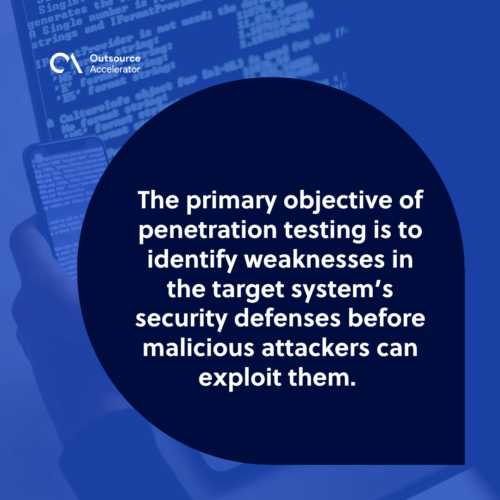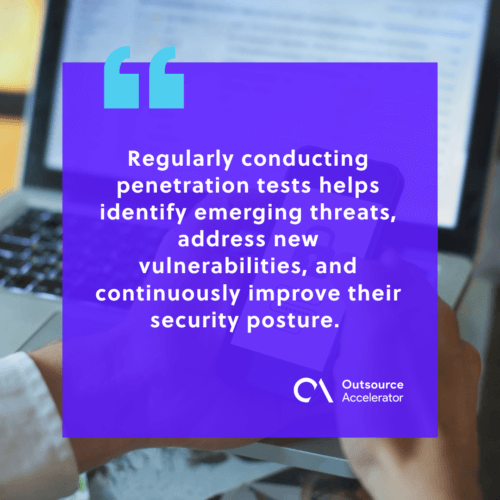Solving cybercrime with penetration testing

Today’s online lifestyle has produced a hyper-connected and information-driven world. Organizations must, therefore, remain ever-vigilant in securing their digital fortresses against those seeking to exploit vulnerabilities.
Penetration testing is a proactive approach that lets businesses assess the resilience of their systems and uncover potential weaknesses before cybercriminals do.
This article explores the power of penetration testing as a defense mechanism, its methodologies, and its crucial role in safeguarding information.
What is penetration testing?
Penetration testing, also called ethical hacking or, more casually, pen tests, is a proactive cybersecurity assessment technique.
It involves systematically stimulating an attack on a computer system, network, or application to identify vulnerabilities and assess security posture.
The primary objective of penetration testing is to identify weaknesses in the target system’s security defenses before malicious attackers can exploit them.
Controlled and authorized attacks let organizations gain insights into their security deficiencies and take appropriate measures to mitigate risks.
Penetration testing is a vital element in a cybersecurity strategy. Specialized professionals or external firms often perform it in an authorized environment to avoid causing harm or disruption to systems and data.

Types of penetration testing
There are several types of penetration testing, each with its own approach and objectives.
Below are the main types:
Black box testing
In black box testing, the tester has no prior knowledge of the target system’s infrastructure or internal workings. They approach the system as an external attacker without any insider information.
This type of penetration testing helps identify vulnerabilities that hackers could exploit with minimal internal knowledge.
White box testing
White box testing, also called clear box or transparent testing, involves the tester’s full knowledge of the target system’s architecture, source code, and internal workings.
This allows them to thoroughly assess the system’s security measures, pinpointing vulnerabilities that might not be evident from an external perspective.
Grey box testing
Grey box testing incorporates elements from both black box and white box testing. Testers have partial knowledge of the target system’s environment, such as basic network information or access credentials.
This approach strikes a balance between simulating external attacks and leveraging internal insights to identify vulnerabilities effectively.
External testing
External penetration testing evaluates the security of externally facing systems, such as web servers, domain controllers, and email servers.
Testers attempt to exploit vulnerabilities that could be exploited by attackers approaching from outside the organization’s network.

Internal testing
Internal penetration testing involves assessing the security of internal network segments, systems, and resources. Testers simulate scenarios where attackers gain internal access, such as through compromised user accounts or devices.
This type of testing helps identify potential lateral movement and escalation of privileges.
Penetration testing process
The penetration testing process can be divided into several phases. While the specific steps may vary depending on the methodology used and the scope of the engagement, the general process typically includes the following:
1. Planning and scoping
The first phase defines the objectives, scope, and rules of engagement for the test.
This involves determining the systems or applications and the methods to be used, including clear goals and expectations.
2. Information gathering and reconnaissance
Testers gather information about the target system or network. They collect publicly available information, scan networks, and identify potential risks.
3. Vulnerability scanning and analysis
Automated tools and manual techniques are used to scan target systems to identify known vulnerabilities. This helps create a baseline understanding of the potential weaknesses and areas where further testing is required.
4. Exploitation and penetration
This serves as the main phase of penetration testing. Testers attempt to exploit the identified vulnerabilities to gain unauthorized access or perform specific actions.
This mainly involves using different attack techniques, such as social engineering, network intrusion, or application-level exploitation, to access sensitive information or take control.
5. Post-exploitation and persistence
If the testers successfully access the target system, they will explore the potential impact of an attacker. They may attempt to escalate privileges or maintain persistence within the system.
6. Reporting and documentation
Once the testing phase is complete, the penetration team documents and analyzes the findings.
They prepare a comprehensive report containing details of vulnerabilities discovered, their severity, and recommendations.
7. Remediation and retesting
After receiving the report, the organization’s IT and security teams should prioritize and address the issues and implement appropriate security controls.
When remediation is complete, teams can retest to confirm that the vulnerabilities have been effectively mitigated.
8. Continuous improvement
Penetration testing is not a one-time activity but an ongoing aspect of a robust security program.
Regularly conducting penetration tests helps identify emerging threats, address new vulnerabilities, and continuously improve their security posture.

Why is penetration testing performed?
Penetration testing is performed for a variety of reasons, all aimed at improving the security of an organization’s systems and data.
Here are some key reasons why penetration testing is conducted:
Assessing security controls
Penetration testing evaluates the effectiveness of existing security controls and measures in place.
It helps determine if the implemented security measures are functioning as intended or if they need to be strengthened.
Testing incident response capability
Penetration testing can assess the organization’s incident response plan and capabilities. It allows organizations to simulate a real-world attack scenario and evaluate their ability to detect, respond to, and recover from an attack.
Meeting compliance requirements
Many industries and regulatory frameworks require organizations to perform penetration testing as part of their compliance obligations.
By conducting regular penetration tests, organizations can demonstrate compliance with industry standards and regulatory requirements.
Enhancing security awareness
Penetration testing can raise employees’ awareness of the importance of security and the potential risks they face. It can help educate employees on identifying and responding to potential security threats, such as social engineering attacks.
Building customer trust
Performing penetration tests demonstrates an organization’s commitment to security and safeguarding customer data.
It reassures customers, partners, and stakeholders about protecting their information and establishes trust in the organization’s security practices.
Proactive risk management
Penetration testing is a proactive measure that helps organizations identify and address security risks before they can be exploited.
By conducting regular testing, organizations can stay ahead of emerging threats, minimize potential damages, and keep up with evolving attack techniques.







 Independent
Independent




